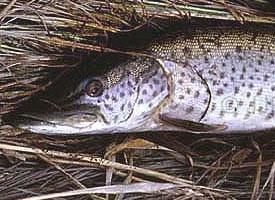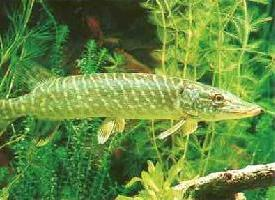
Váhy a míry
| Délka | od 0,8 do 1,15 m |
|---|
Stav ohrožení
| Ohrožen |
Popis zvířete
The Amur pike, scientifically known as Esox reicherti, is a captivating species of freshwater fish belonging to the genus Esox, which is renowned for its members, including the northern pike and other pike species. This intriguing creature is native to the Amur River system, which meanders through parts of Russia and China, presenting a unique biogeographical distribution that influences its ecological niche and behavior.Physically, the Amur pike resembles its close relative, the northern pike, but it exhibits several distinguishing features. It typically reaches lengths of up to 115 centimeters, though most specimens are smaller, showcasing a streamlined body that is built for ambush predation. The body coloration of the Amur pike is a captivating mix of olive green to silver-gray, adorned with short, light bar-like spots or stripes, which provide excellent camouflage among the aquatic vegetation and murky waters of its habitat.
The head of the Amur pike is elongated with a somewhat flattened snout, housing a mouth equipped with numerous sharp teeth. These teeth are perfectly adapted for gripping onto slippery prey, such as fish, which constitutes the majority of its diet. However, the Amur pike is also known to consume amphibians and occasionally small mammals or birds, showcasing its opportunistic feeding behavior.
Amur pikes are solitary creatures, except during the spawning season, which typically occurs in the spring. During this time, they migrate to shallow, vegetated areas of rivers and lakes to lay their eggs. The females deposit thousands of eggs, which adhere to aquatic plants, and neither parent exhibits any form of parental care post-spawning. This reproductive strategy ensures that, despite the high mortality rate of eggs and fry, a sufficient number of offspring survive to adulthood.
The habitat of the Amur pike is characterized by slow-moving or standing waters with abundant vegetation. This environment not only provides them with ample hiding spots for ambushing prey but also offers protection from larger predators. Their preference for such habitats underscores the importance of healthy aquatic ecosystems for their survival.
Conservation-wise, the Amur pike faces threats from habitat degradation, pollution, and overfishing. Although it is not currently listed as endangered, its well-being is intrinsically linked to the health of the Amur River basin and its aquatic ecosystems. Efforts to preserve their natural habitats and ensure sustainable fishing practices are crucial for the continued survival of this remarkable species.
In conclusion, the Amur pike is a fascinating and important species within its ecosystem, embodying the complexity and interconnectedness of aquatic life. Its unique features and behaviors contribute to the biodiversity of the Amur River system, making it a species of interest for conservationists, anglers, and nature enthusiasts alike.
Podobná zvířata
Nové fotografie zvířat
Top 10 zvířat
- Chinese water dragon (Physignathus cocincinus)
- Galápagos tortoise (Geochelone nigra complex)
- Dolphin gull (Leucophaeus scoresbii)
- Japanese macaque (Macaca fuscata)
- Colombian red howler (Alouatta seniculus)
- Sea urchins (Echinoidea)
- Moustached guenon (Cercopithecus cephus)
- Diana monkey (Cercopithecus diana)
- Common reed warbler (Acrocephalus scirpaceus)
- Common house mosquito (Culex pipiens)
